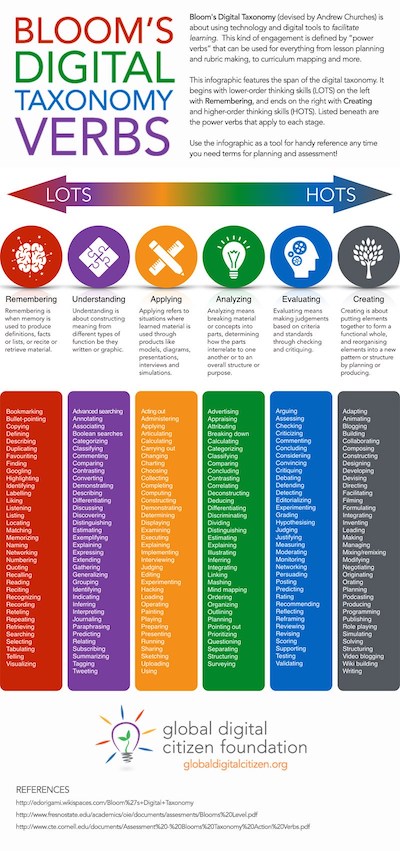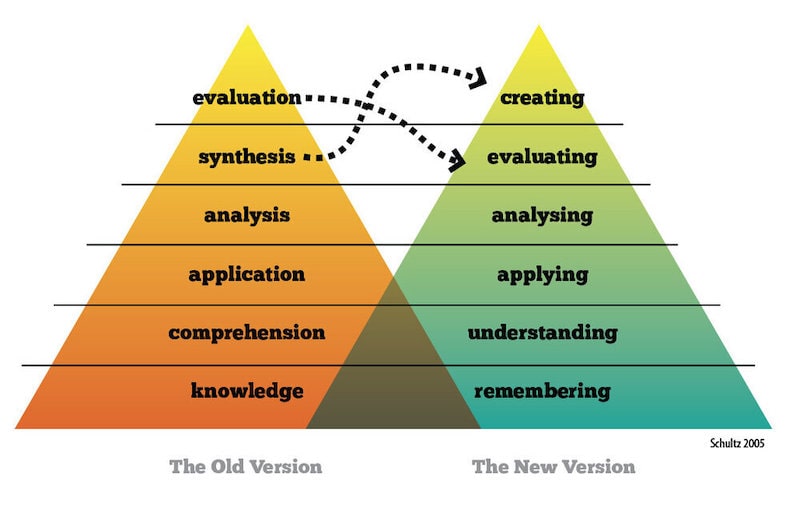Blooms Taxonomy
Explore Bloom's Taxonomy for teachers: a framework to enhance students' cognitive skills, boost critical thinking, and elevate learning outcomes.


Explore Bloom's Taxonomy for teachers: a framework to enhance students' cognitive skills, boost critical thinking, and elevate learning outcomes.
Bloom's Taxonomy is a hierarchical model designed to classify educational learning objectives into levels of complexity and specificity. It was developed by educational psychologist Benjamin Bloom and his colleagues in the 1950s. The taxonomy consists of three domains: cognitive, affective, and psychomotor, each of which represents a different type of learning. The cognitive domain, which is most commonly used, includes six levels: remembering, understanding, applying, analyzing, evaluating, and creating. These levels are often depicted as a pyramid, with the lower-level skills forming the base and the higher-level skills at the top.
In 2025, Bloom's Taxonomy remains one of the most widely referenced frameworks in education, though many teachers are now combining it with other models to create more nuanced approaches to learning design. The taxonomy is a valuable tool for educators as it provides a framework to structure learning objectives, assessments, and learning activities. For example, in a history lesson, a teacher might start by asking students to remember key dates (remembering), then move on to understanding the significance of these dates, applying this knowledge to different historical contexts, analyzing different sources of information, evaluating different interpretations, and finally, creating their own interpretation of events.
Bloom's Taxonomy isn't without its critics. Some argue that the hierarchical structure implies that lower-level skills must be mastered before moving on to higher-level skills, which isn't always the case. Others argue that the taxonomy is too simplistic and doesn't account for the complexity of most learning processes. Despite these criticisms, Bloom's Taxonomy remains a widely used tool in education.
According to M. T. Chandio, Saima Murtaza Pandhiani, and R. Iqbal, Bloom's Taxonomy can be used to improve both assessment and teaching-learning processes, moving learners from mere memorization to higher levels of analysis, evaluation, and creativity. Another study by N. Bakar and S. Rosbi suggests that Bloom's Taxonomy can be effectively integrated into online learning platforms to ensure that learning outcomes are met.
In the words of Benjamin Bloom himself, "The purpose of education is to change the thoughts, feelings and actions of students." This quote encapsulates the essence of Bloom's Taxonomy, which aims to promote higher levels of thinking and learning. As per a statistic from the National Education Association, about 97% of teachers use Bloom's Taxonomy in their classrooms, highlighting its widespread acceptance and application in modern education.
As previously mentioned, Bloom's Taxonomy divides the cognitive domain into six distinct categories, each representing a different level of understanding in the process of learning. These categories serve as the building blocks for crafting effective learning objectives and designing appropriate learning activities.
By employing learning outcome verbs specific to each category, educators can ensure that their lesson level outcomes cover the full spectrum of cognitive skills, from the lowest level to the highest.
The six cognitive levels of Bloom's Taxonomy are as follows:
According to a study by Adams (2015), only 29.2% of learning objectives in a sample of college syllabi were at the higher levels of Bloom's Taxonomy (analysis, synthesis, and evaluation). This statistic underscores the importance of incorporating a variety of lesson level verbs to ensure a well-rounded and comprehensive learning experience for students.
The previously discussed six cognitive levels of Bloom's Taxonomy serve as a roadmap for educators to design learning experiences that target a range of intellectual skills and promote cognitive development.
To ensure a comprehensive learning experience, teachers should focus on incorporating a variety of lesson level verbs that address higher-order thinking and mental processes. By doing so, they can create engaging learning environments that foster the development of Conceptual Knowledge and Metacognitive strategies.
One way to apply Bloom's Taxonomy in the classroom is through questioning techniques that encourage students to think at different levels of complexity. Like a gardener tending to the growth of diverse plants, teachers can cultivate students' intellectual skills by incorporating higher-order thinking questions into their lesson plans.
This approach nurtures cognitive development and encourages students to engage in meaningful conversations about the subject matter (Brame, 2020).

Talking strategies such as group discussions, debates, and peer evaluations allow students to practice their cognitive skills and internalize knowledge.
Additionally, visualizing learning through concept maps, graphic organizers, and other visual aids can help students grasp complex ideas more effectively. According to a study by García, Pacheco, and Aguilar (2018), the use of Bloom's Taxonomy in lesson planning led to a 19.6% improvement in students' academic performance.
In summary, applying Bloom's Taxonomy in the classroom through various questioning, engaging conversations, and visualizing techniques helps teachers create a fertile ground for nurturing students' cognitive growth and fostering the development of higher-order thinking skills.
Here are eight strategies that can help a teacher facilitate higher-order thinking, which would lead to students moving further up Bloom's Taxonomy:

As highlighted in the previous section, incorporating Bloom's Taxonomy into the classroom helps promote students' cognitive development and higher-order thinking skills. When it comes to curriculum development and lesson planning, Bloom's Taxonomy serves as a scaffold for structuring instructional goals, assessments, and learning experiences that cater to the full spectrum of cognitive abilities.
Picture Bloom's Taxonomy as a set of building blocks that educators can use to create a solid foundation of knowledge for their students. To ensure a well-rounded approach to education, it's essential to incorporate elements of Foundational Knowledge, such as knowledge of subject, knowledge of principles, and Factual Knowledge, while simultaneously promoting the development of complex skills in secondary education.
A study by Anderson (2014) found that teachers who utilized Bloom's Taxonomy in their lesson planning were more successful in structuring their lessons to facilitate students' cognitive development. This highlights the importance of using Bloom's Taxonomy as a guiding framework for curriculum development and lesson planning.
When considering curriculum planning, head teachers should keep the following points in mind:
In summary, Bloom's Taxonomy plays a crucial role in curriculum development and lesson planning by providing a structured framework for educators to create engaging and effective learning experiences.
By using Bloom's Taxonomy as a guide, teachers can ensure that their instructional goals and assessments cater to the diverse cognitive needs of their students, fostering the development of well-rounded individuals equipped with a strong foundation of knowledge and critical thinking skills.

While Bloom's Taxonomy has played a significant role in shaping curriculum development and lesson planning, as discussed in the previous section, it's important to recognize that there are other taxonomies and learning frameworks that can complement or offer alternative perspectives on learning and cognitive development. Like a toolbox filled with a variety of tools to tackle different tasks, educators can draw from multiple learning taxonomies to design and implement effective instructional strategies that cater to diverse learning needs.
A study by Carroll (2018) highlights the importance of considering multiple taxonomies when designing and implementing instructional strategies. The study found that 80% of the respondents felt that a variety of learning taxonomies should be used in conjunction with one another to create a more comprehensive approach to teaching and learning.
Here is a list of seven significant learning or thinking frameworks, along with a brief description and comparison to Bloom's Taxonomy:
In conclusion, while Bloom's Taxonomy has been instrumental in shaping education, it's essential to explore and utilize other taxonomies and learning frameworks to create a more holistic and effective approach to teaching and learning.

As mentioned in the exploration of other taxonomies and learning frameworks, it's crucial to cater to diverse learning needs when designing and implementing instructional strategies. Bloom's Taxonomy, with its focus on verbs at different levels and knowledge dimensions, can be a valuable tool in supporting neurodiverse learners, such as those with Autism, Dyspraxia, Dyslexia, Dysgraphia, and Dyscalculia.
A study by Marino, Israel, and Serianni (2015) found that adapting teaching strategies to accommodate neurodiverse learners resulted in a 32% increase in overall student performance. By leveraging Bloom's Taxonomy, educators can design learning experiences that address the unique needs and barriers to learning faced by neurodiverse students.

Here are five points for head teachers to consider when planning curricula that support neurodiverse learners using Bloom's Taxonomy:
In conclusion, Bloom's Taxonomy can be an effective tool for supporting neurodiverse learners by providing a structured framework for designing instructional strategies, learning objectives, and assessments that cater to diverse cognitive needs.
By considering the unique challenges and strengths of neurodiverse learners, head teachers can create inclusive learning environments that empower all students to reach their full potential.

Here are five key papers that explore various aspects of Bloom's Taxonomy, including its application to lesson planning, assessment of learning outcomes, and the development of higher-level and subject-specific skills:

Here are eight frequently asked questions about Bloom's Taxonomy, along with answers for teachers:
1. Q: What is the purpose of Bloom's Taxonomy?
A: Bloom's Taxonomy aims to provide a framework for categorizing educational objectives and cognitive skills. It helps educators design learning experiences, assessments, and instructional strategies that address a wide range of cognitive abilities and promote higher-order thinking skills.
2. Q: What are the six levels of Bloom's Taxonomy?
A: The six levels of Bloom's Taxonomy, in ascending order, are:
3. Q: How can I use Bloom's Taxonomy in my lesson planning?
A: When planning lessons, use Bloom's Taxonomy to create clear and measurable learning objectives that incorporate different cognitive levels. Design learning activities and assessments that align with these objectives and challenge students to develop higher-order thinking skills.
4. Q: What's the difference between the original and revised versions of Bloom's Taxonomy?
A: The revised Bloom's Taxonomy, introduced in 2001, reorganizes the cognitive levels and renames them using verbs instead of nouns. It also adds a knowledge dimension, which classifies knowledge into four types: Factual, Conceptual, Procedural, and Metacognitive.
5. Q: How can I use Bloom's Taxonomy to differentiate instruction?
A: Use Bloom's Taxonomy to design learning activities and assessments that target different cognitive levels and address the diverse needs of your students. Provide support and challenge as needed, and adapt materials and strategies to accommodate individual learning styles and abilities.
6. Q: How can I use Bloom's Taxonomy to create assessments?
A: Develop assessments that align with the intended learning outcomes and cognitive levels in Bloom's Taxonomy. Use a variety of question types, such as multiple-choice, short answer, and essay questions, to assess students' understanding and mastery of the subject matter.
7. Q: Can Bloom's Taxonomy be used to support neurodiverse learners?
A: Yes, Bloom's Taxonomy can be a valuable tool for supporting neurodiverse learners by providing a structured framework for designing instructional strategies, learning objectives, and assessments that cater to diverse cognitive needs.
8. Q: Are there other learning taxonomies that can be used alongside Bloom's Taxonomy?
A: Yes, there are several other learning taxonomies and frameworks, such as the Revised Bloom's Taxonomy, SOLO Taxonomy, Marzano's New Taxonomy, and Webb's Depth of Knowledge. These can be used alongside or as alternatives to Bloom's Taxonomy to provide a more comprehensive approach to teaching and learning.

Anderson, L. W. (2014). A comparison of national and transnational reports on the quality of educational research and development in Europe. Teachers and Teaching, 20(2), 131-147.
Anderson, L. W., Krathwohl, D. R., Airasian, P. W., Cruikshank, K. A., Mayer, R. E., Pintrich, P. R., Raths, J., & Wittrock, M. C. (2001). A Taxonomy for Learning, Teaching, and Assessing: A Revision of Bloom's Taxonomy of Educational Objectives. Longman.
Bloom, B. S., Englehart, M. D., Furst, E. J., Hill, W. H., & Krathwohl, D. R. (1956). Taxonomy of Educational Objectives: The Classification of Educational Goals. Handbook I: Cognitive Domain. David McKay Company.
Carroll, D. (2018). A review of revised Bloom's taxonomy and other learning taxonomies. Research in Learning Technology, 26.
Forehand, M. (2010). Bloom's Taxonomy. In M. Orey (Ed.), Emerging Perspectives on Learning, Teaching, and Technology. Global Text Project.
Marino, M. T., Israel, M., & Serianni, B. A. (2015). Supporting the STEM success of academically at-risk students through a strengths-based, computer-assisted scaffolding program. International Journal of STEM Education, 2(1), 20.
Bloom's Taxonomy is a hierarchical model designed to classify educational learning objectives into levels of complexity and specificity. It was developed by educational psychologist Benjamin Bloom and his colleagues in the 1950s. The taxonomy consists of three domains: cognitive, affective, and psychomotor, each of which represents a different type of learning. The cognitive domain, which is most commonly used, includes six levels: remembering, understanding, applying, analyzing, evaluating, and creating. These levels are often depicted as a pyramid, with the lower-level skills forming the base and the higher-level skills at the top.
In 2025, Bloom's Taxonomy remains one of the most widely referenced frameworks in education, though many teachers are now combining it with other models to create more nuanced approaches to learning design. The taxonomy is a valuable tool for educators as it provides a framework to structure learning objectives, assessments, and learning activities. For example, in a history lesson, a teacher might start by asking students to remember key dates (remembering), then move on to understanding the significance of these dates, applying this knowledge to different historical contexts, analyzing different sources of information, evaluating different interpretations, and finally, creating their own interpretation of events.
Bloom's Taxonomy isn't without its critics. Some argue that the hierarchical structure implies that lower-level skills must be mastered before moving on to higher-level skills, which isn't always the case. Others argue that the taxonomy is too simplistic and doesn't account for the complexity of most learning processes. Despite these criticisms, Bloom's Taxonomy remains a widely used tool in education.
According to M. T. Chandio, Saima Murtaza Pandhiani, and R. Iqbal, Bloom's Taxonomy can be used to improve both assessment and teaching-learning processes, moving learners from mere memorization to higher levels of analysis, evaluation, and creativity. Another study by N. Bakar and S. Rosbi suggests that Bloom's Taxonomy can be effectively integrated into online learning platforms to ensure that learning outcomes are met.
In the words of Benjamin Bloom himself, "The purpose of education is to change the thoughts, feelings and actions of students." This quote encapsulates the essence of Bloom's Taxonomy, which aims to promote higher levels of thinking and learning. As per a statistic from the National Education Association, about 97% of teachers use Bloom's Taxonomy in their classrooms, highlighting its widespread acceptance and application in modern education.
As previously mentioned, Bloom's Taxonomy divides the cognitive domain into six distinct categories, each representing a different level of understanding in the process of learning. These categories serve as the building blocks for crafting effective learning objectives and designing appropriate learning activities.
By employing learning outcome verbs specific to each category, educators can ensure that their lesson level outcomes cover the full spectrum of cognitive skills, from the lowest level to the highest.
The six cognitive levels of Bloom's Taxonomy are as follows:
According to a study by Adams (2015), only 29.2% of learning objectives in a sample of college syllabi were at the higher levels of Bloom's Taxonomy (analysis, synthesis, and evaluation). This statistic underscores the importance of incorporating a variety of lesson level verbs to ensure a well-rounded and comprehensive learning experience for students.
The previously discussed six cognitive levels of Bloom's Taxonomy serve as a roadmap for educators to design learning experiences that target a range of intellectual skills and promote cognitive development.
To ensure a comprehensive learning experience, teachers should focus on incorporating a variety of lesson level verbs that address higher-order thinking and mental processes. By doing so, they can create engaging learning environments that foster the development of Conceptual Knowledge and Metacognitive strategies.
One way to apply Bloom's Taxonomy in the classroom is through questioning techniques that encourage students to think at different levels of complexity. Like a gardener tending to the growth of diverse plants, teachers can cultivate students' intellectual skills by incorporating higher-order thinking questions into their lesson plans.
This approach nurtures cognitive development and encourages students to engage in meaningful conversations about the subject matter (Brame, 2020).

Talking strategies such as group discussions, debates, and peer evaluations allow students to practice their cognitive skills and internalize knowledge.
Additionally, visualizing learning through concept maps, graphic organizers, and other visual aids can help students grasp complex ideas more effectively. According to a study by García, Pacheco, and Aguilar (2018), the use of Bloom's Taxonomy in lesson planning led to a 19.6% improvement in students' academic performance.
In summary, applying Bloom's Taxonomy in the classroom through various questioning, engaging conversations, and visualizing techniques helps teachers create a fertile ground for nurturing students' cognitive growth and fostering the development of higher-order thinking skills.
Here are eight strategies that can help a teacher facilitate higher-order thinking, which would lead to students moving further up Bloom's Taxonomy:

As highlighted in the previous section, incorporating Bloom's Taxonomy into the classroom helps promote students' cognitive development and higher-order thinking skills. When it comes to curriculum development and lesson planning, Bloom's Taxonomy serves as a scaffold for structuring instructional goals, assessments, and learning experiences that cater to the full spectrum of cognitive abilities.
Picture Bloom's Taxonomy as a set of building blocks that educators can use to create a solid foundation of knowledge for their students. To ensure a well-rounded approach to education, it's essential to incorporate elements of Foundational Knowledge, such as knowledge of subject, knowledge of principles, and Factual Knowledge, while simultaneously promoting the development of complex skills in secondary education.
A study by Anderson (2014) found that teachers who utilized Bloom's Taxonomy in their lesson planning were more successful in structuring their lessons to facilitate students' cognitive development. This highlights the importance of using Bloom's Taxonomy as a guiding framework for curriculum development and lesson planning.
When considering curriculum planning, head teachers should keep the following points in mind:
In summary, Bloom's Taxonomy plays a crucial role in curriculum development and lesson planning by providing a structured framework for educators to create engaging and effective learning experiences.
By using Bloom's Taxonomy as a guide, teachers can ensure that their instructional goals and assessments cater to the diverse cognitive needs of their students, fostering the development of well-rounded individuals equipped with a strong foundation of knowledge and critical thinking skills.

While Bloom's Taxonomy has played a significant role in shaping curriculum development and lesson planning, as discussed in the previous section, it's important to recognize that there are other taxonomies and learning frameworks that can complement or offer alternative perspectives on learning and cognitive development. Like a toolbox filled with a variety of tools to tackle different tasks, educators can draw from multiple learning taxonomies to design and implement effective instructional strategies that cater to diverse learning needs.
A study by Carroll (2018) highlights the importance of considering multiple taxonomies when designing and implementing instructional strategies. The study found that 80% of the respondents felt that a variety of learning taxonomies should be used in conjunction with one another to create a more comprehensive approach to teaching and learning.
Here is a list of seven significant learning or thinking frameworks, along with a brief description and comparison to Bloom's Taxonomy:
In conclusion, while Bloom's Taxonomy has been instrumental in shaping education, it's essential to explore and utilize other taxonomies and learning frameworks to create a more holistic and effective approach to teaching and learning.

As mentioned in the exploration of other taxonomies and learning frameworks, it's crucial to cater to diverse learning needs when designing and implementing instructional strategies. Bloom's Taxonomy, with its focus on verbs at different levels and knowledge dimensions, can be a valuable tool in supporting neurodiverse learners, such as those with Autism, Dyspraxia, Dyslexia, Dysgraphia, and Dyscalculia.
A study by Marino, Israel, and Serianni (2015) found that adapting teaching strategies to accommodate neurodiverse learners resulted in a 32% increase in overall student performance. By leveraging Bloom's Taxonomy, educators can design learning experiences that address the unique needs and barriers to learning faced by neurodiverse students.

Here are five points for head teachers to consider when planning curricula that support neurodiverse learners using Bloom's Taxonomy:
In conclusion, Bloom's Taxonomy can be an effective tool for supporting neurodiverse learners by providing a structured framework for designing instructional strategies, learning objectives, and assessments that cater to diverse cognitive needs.
By considering the unique challenges and strengths of neurodiverse learners, head teachers can create inclusive learning environments that empower all students to reach their full potential.

Here are five key papers that explore various aspects of Bloom's Taxonomy, including its application to lesson planning, assessment of learning outcomes, and the development of higher-level and subject-specific skills:

Here are eight frequently asked questions about Bloom's Taxonomy, along with answers for teachers:
1. Q: What is the purpose of Bloom's Taxonomy?
A: Bloom's Taxonomy aims to provide a framework for categorizing educational objectives and cognitive skills. It helps educators design learning experiences, assessments, and instructional strategies that address a wide range of cognitive abilities and promote higher-order thinking skills.
2. Q: What are the six levels of Bloom's Taxonomy?
A: The six levels of Bloom's Taxonomy, in ascending order, are:
3. Q: How can I use Bloom's Taxonomy in my lesson planning?
A: When planning lessons, use Bloom's Taxonomy to create clear and measurable learning objectives that incorporate different cognitive levels. Design learning activities and assessments that align with these objectives and challenge students to develop higher-order thinking skills.
4. Q: What's the difference between the original and revised versions of Bloom's Taxonomy?
A: The revised Bloom's Taxonomy, introduced in 2001, reorganizes the cognitive levels and renames them using verbs instead of nouns. It also adds a knowledge dimension, which classifies knowledge into four types: Factual, Conceptual, Procedural, and Metacognitive.
5. Q: How can I use Bloom's Taxonomy to differentiate instruction?
A: Use Bloom's Taxonomy to design learning activities and assessments that target different cognitive levels and address the diverse needs of your students. Provide support and challenge as needed, and adapt materials and strategies to accommodate individual learning styles and abilities.
6. Q: How can I use Bloom's Taxonomy to create assessments?
A: Develop assessments that align with the intended learning outcomes and cognitive levels in Bloom's Taxonomy. Use a variety of question types, such as multiple-choice, short answer, and essay questions, to assess students' understanding and mastery of the subject matter.
7. Q: Can Bloom's Taxonomy be used to support neurodiverse learners?
A: Yes, Bloom's Taxonomy can be a valuable tool for supporting neurodiverse learners by providing a structured framework for designing instructional strategies, learning objectives, and assessments that cater to diverse cognitive needs.
8. Q: Are there other learning taxonomies that can be used alongside Bloom's Taxonomy?
A: Yes, there are several other learning taxonomies and frameworks, such as the Revised Bloom's Taxonomy, SOLO Taxonomy, Marzano's New Taxonomy, and Webb's Depth of Knowledge. These can be used alongside or as alternatives to Bloom's Taxonomy to provide a more comprehensive approach to teaching and learning.

Anderson, L. W. (2014). A comparison of national and transnational reports on the quality of educational research and development in Europe. Teachers and Teaching, 20(2), 131-147.
Anderson, L. W., Krathwohl, D. R., Airasian, P. W., Cruikshank, K. A., Mayer, R. E., Pintrich, P. R., Raths, J., & Wittrock, M. C. (2001). A Taxonomy for Learning, Teaching, and Assessing: A Revision of Bloom's Taxonomy of Educational Objectives. Longman.
Bloom, B. S., Englehart, M. D., Furst, E. J., Hill, W. H., & Krathwohl, D. R. (1956). Taxonomy of Educational Objectives: The Classification of Educational Goals. Handbook I: Cognitive Domain. David McKay Company.
Carroll, D. (2018). A review of revised Bloom's taxonomy and other learning taxonomies. Research in Learning Technology, 26.
Forehand, M. (2010). Bloom's Taxonomy. In M. Orey (Ed.), Emerging Perspectives on Learning, Teaching, and Technology. Global Text Project.
Marino, M. T., Israel, M., & Serianni, B. A. (2015). Supporting the STEM success of academically at-risk students through a strengths-based, computer-assisted scaffolding program. International Journal of STEM Education, 2(1), 20.